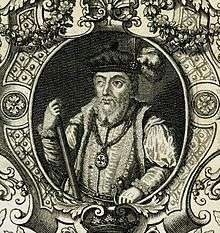Constantino of Braganza
Dom Constantino of Braganza (Portuguese: Constantino de Bragança; 1528–1575) was a Portuguese nobleman, conquistador, and administrator of the Portuguese Empire. Born a member of the powerful House of Braganza, he is best known for having served as Viceroy of Portuguese India and for initiating the Portuguese conquest of Sri Lanka.
Constantino de Bragança | |
|---|---|
 Constantino de Bragança | |
| Viceroy of Portuguese India | |
| In office 1558–1561 | |
| Monarch | King Dom Sebastian of Portugal |
| Preceded by | Dom Francisco Barreto |
| Succeeded by | Dom Francisco Coutinho |
| Captain of Ribeira Grande | |
| In office 1562 – 1570? | |
| Monarch | Dom Sebastian of Portugal |
| Preceded by | Dom Manuel de Andrade |
| Succeeded by | Office eliminated |
| Personal details | |
| Born | 1528 Kingdom of Portugal |
| Died | July 15, 1575 (aged 46–47) Kingdom of Portugal |
| Nationality | Portuguese |
| Spouse(s) | Maria de Melo |
Biography
He was the son of Dom James, 4th Duke of Braganza from his second marriage.
When he was 19 years old, he was appointed by King Dom John III of Portugal as his special ambassador to the baptism ceremony of King Henry II of France's son.
In 1558, he was appointed by the regent Dona Catherine of Habsburg (King Dom John III's widow) as the 20th Governor of Portuguese India, using also the title of 7th Viceroy. He left Lisbon on April 7, 1558, and arrived in Goa on September 3.
He was a remarkable organiser of the local State, and he conquered Daman, Ceylon (nowadays known as Sri Lanka) and the island of Manar.
A first expedition, led by Viceroy Dom Constantino de Bragança in 1560, failed to subdue Jaffna, but captured Mannar Island.[1] By June 1619, despite sharp resistance from Cankili II of Jaffna, there were two Portuguese expeditions; a naval expedition that was repulsed by the Malabari corsairs and another expedition by Dom Filipe de Oliveira and his land army of 5,000, which defeated Cankili and conquered Jaffna, strengthening Portuguese control of shipping routes through the Palk Strait.[2]
His government in India took three years and eight days, and during that period he made important reforms. He was considered by the historian C. R. Boxer one of the most fanatic Portuguese governors of India together with Dom Francisco Barreto (1555–1558).
He protected the poet Luis Vaz de Camões, during his stay in India.
He was later governor of Ribeira Grande, in the island of Santo Antão, Portuguese Cape Verde, from 1562.
Dom Constantino afterwards returned to the Kingdom. There he married his cousin, D. Maria de Melo, daughter of the 1st Marquess of Ferreira and 1st Count of Tentúgal, D. Rodrigo de Melo, and Dona Brites de Menezes (daughter of Dom Antão de Almada, 3rd Count of Avranches). The couple had no issue.
Tooth relic
According to Mutu Coomara Swamy, Constantino supposedly played a part in capturing and destroying the Tooth-Relic of Gotama Buddha, during the wars of the Portugeese. The native authorities however, maintained the relic was kept safe from harm.[3]
Ancestry
| Ancestors of Constantino of Braganza | |||||||||||||||||||||||||||||||||||||||||||||||||||||||||||||||||||||||||||||||||||||||||||||||||||||||||||||||||||||||||||||||||||||||||||||||||||||||||||||||||||||||||||||||||||||||||||||||||||||||||||||||||||||||||||||||||||||||||||||||||||||||||||||||||||||||||||||||||||||||||
|---|---|---|---|---|---|---|---|---|---|---|---|---|---|---|---|---|---|---|---|---|---|---|---|---|---|---|---|---|---|---|---|---|---|---|---|---|---|---|---|---|---|---|---|---|---|---|---|---|---|---|---|---|---|---|---|---|---|---|---|---|---|---|---|---|---|---|---|---|---|---|---|---|---|---|---|---|---|---|---|---|---|---|---|---|---|---|---|---|---|---|---|---|---|---|---|---|---|---|---|---|---|---|---|---|---|---|---|---|---|---|---|---|---|---|---|---|---|---|---|---|---|---|---|---|---|---|---|---|---|---|---|---|---|---|---|---|---|---|---|---|---|---|---|---|---|---|---|---|---|---|---|---|---|---|---|---|---|---|---|---|---|---|---|---|---|---|---|---|---|---|---|---|---|---|---|---|---|---|---|---|---|---|---|---|---|---|---|---|---|---|---|---|---|---|---|---|---|---|---|---|---|---|---|---|---|---|---|---|---|---|---|---|---|---|---|---|---|---|---|---|---|---|---|---|---|---|---|---|---|---|---|---|---|---|---|---|---|---|---|---|---|---|---|---|---|---|---|---|---|---|---|---|---|---|---|---|---|---|---|---|---|---|---|---|---|---|---|---|---|---|---|---|---|---|---|---|---|---|---|---|---|
| |||||||||||||||||||||||||||||||||||||||||||||||||||||||||||||||||||||||||||||||||||||||||||||||||||||||||||||||||||||||||||||||||||||||||||||||||||||||||||||||||||||||||||||||||||||||||||||||||||||||||||||||||||||||||||||||||||||||||||||||||||||||||||||||||||||||||||||||||||||||||
See also
- House of Braganza
- Duke of Braganza
- Portuguese India
- List of colonial heads of Portuguese India
References
- Abeysinghe, T. Jaffna Under the Portuguese, p.3
- Kunarasa, K The Jaffna Dynasty, p. 115
- Mutu Coomara Swamy. The Dathavansa, Or The History of the Tooth-relic of Gotama Buddha. Trübner & Co. p. xix.
- Nobreza de Portugal e do Brasil – Vol. II, page 443. Published by Zairol Lda., Lisbon 1989.
External links
| Preceded by Francisco Barreto |
7th Viceroy of Portuguese India (1558–1561) |
Succeeded by Francisco Coutinho, count of Redondo |
| Preceded by Manuel de Andrade |
Colonial heads of Ribeira Grande, Portuguese Cape Verde (1562 - early 1570s) |
Succeeded by eliminated |
